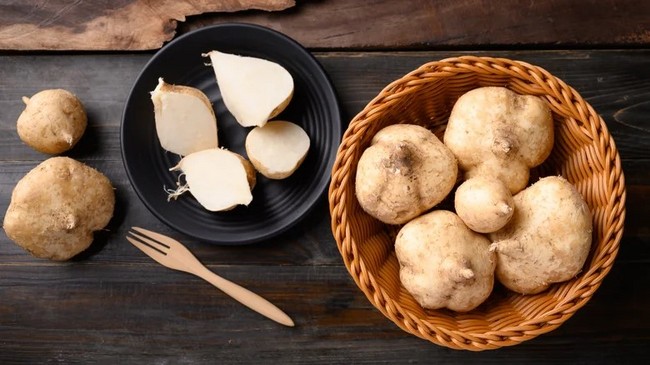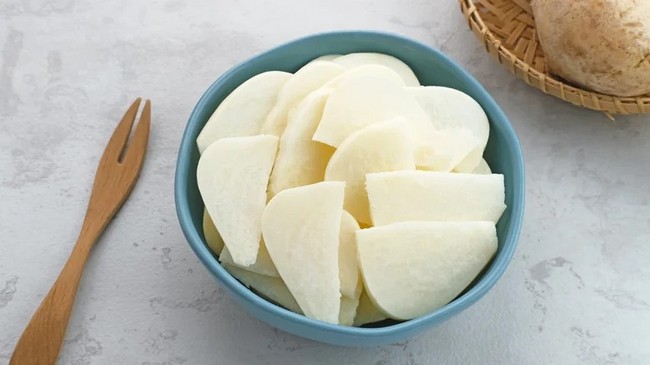✕



✕

Tag:jícama storage and preservation 2024-12-25 13:28

Nungning20/Shutterstock
Anybody who's eaten jícama knows that it's an easy vegetable to love. Its flavor is so mild and its texture so perfectly crunchy that it's a natural ingredient for slaws and other super-fresh preparations. Is it an easy vegetable to store, though? One would hope: These things can grow up to 5 pounds, so you very well may end up with leftovers.
Luckily, like other root vegetables, jícama keeps pretty well. Whole, unpeeled jícama, in fact, can keep up to four months under the right conditions. They like a temperature between 55 and 59 degrees Fahrenheit, and they should be kept dry, like in a chilly, dark basement. After a couple of months, they might start sprouting a stem, which will make the flesh less juicy, but they'll still be edible.
Chances are, though, that you only need to keep your jícama fresh for a shorter period — maybe just until you get around to whipping up some crunchy apple jícama slaw. You have to peel jícama before you cook and eat it, but be sure to leave the skin on until you're ready to cook, as this will keep the vegetable fresh. You can store a whole, unpeeled jícama in your fridge's crisper drawer or at a cool room temperature for two to three weeks; just make sure it stays dry. After you peel or cut it, jícama will still keep for a respectable amount of time. Think up to a week in the fridge if it's wrapped in plastic.
Where jícama comes from and how to cook it

tyasindayanti/Shutterstock
You'll often see jícama compared to other root vegetables. It's sometimes even called the Mexican turnip. In truth, however, these plants are from entirely different families. Like broccoli, kale, and cabbage, the turnip is a member of the mustard (or Brassicaceae) family, whereas jícama, like peas and legumes, is a member of the family Fabaceae; while the root grows beneath the soil, the aboveground parts of the plant form flowers and eventually pea pods. Fun fact: All those other parts of jícama are toxic. Only the root is edible.
Native to Central and South America, jícama was introduced to Asia by Spanish colonists, which is why you'll find it in cuisines on both sides of the Pacific Ocean. In recent years, as folks have continued seeking out low-carb, low-calorie dietary options, it's even become a bit trendy, with Trader Joe's selling items like "thin jícama wraps" that can be used as taco shells. One of this veggie's key selling points is its versatility: It can be eaten raw and fresh, like carrot sticks; added to a stir-fry, like water chestnuts; or even turned into low-carb, high-fiber fries in an air fryer or regular oven. Though jícama can grow larger, as mentioned, look for specimens that are 4 pounds or less when you're shopping — the bigger veggies can get starchy and lose their crunch. Also keep in mind that the skin should be firm and smooth and free from blemishes or cracks.
The Key To Cooking Up The Crispiest Salmon Every Time
Ditch The Foil And Say Goodbye To Soggy Baked Potatoes
Is Soft Serve Just Melted Ice Cream?
Pizza Hut Is Bringing A Beloved Menu Item Back, But You Better Go Fast
Taco Bell's Newest Chalupa Mashes Up 2 Discontinued Menu Items
Instantly Elevate Store-Bought Icing With A Worldwide Favorite Spread
About Us Terms of Service Privacy Policy Contact Us
Hotline(+86)17301604571
 Enterprise WeChat
Enterprise WeChat
for Client Service
 EZBuy
EZBuy
WeChat APP
Sinoexpo Digital Platform
Shanghai Sinoexpo Informa Markets International Exhibition Co., Ltd. All rights reserved
沪ICP备05034851号-77
 沪公网安备31010402000543号
沪公网安备31010402000543号